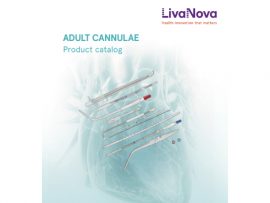Abstract Background Extracorporeal cardiopulmonary resuscitation (ECPR) is increasingly used for refractory cardiac arrest across the world, but its cost-effectiveness remains uncertain. We conducted this systematic review to assess the available..
Read MoreUniversity Conference Center Penn State Health Milton S. Hershey Medical Center and Penn State College of Medicine 30 Conference Dr. Hershey, PA 17033 Internet Live Course This training will be..
Read MoreIn modern surgical practice,managing perioperative blood loss typically exceeding 500ml to 1liter. is a critical factor impacting patient outcomes ,morbidity and resource mobilization. TYPES OF TRANSFUSION Allogeneic(Homologous) blood transfusion involves..
Read MoreAbstract Objectives The full extent of the COVID-19 pandemic’s impact during different phases of the pandemic and the recovery of cardiac surgical services in the United Kingdom have not been..
Read MoreAbstract Objectives Residual heparinization is a preventable cause of coagulopathy following cardiac surgery. The aim of this work was to assess the proportion of patients with residual heparinization following cardiac..
Read MoreAbstract Background Veno-venous extracorporeal membrane oxygenation (VV-ECMO) supports critically ill patients with respiratory failure. However, ECMO may induce systemic inflammation, hemolysis, and hemodilution, potentially resulting in endothelial activation and damage. Therefore,..
Read MoreAbstract Introduction Blood Stream Infections (BSI) occur in 3-35% of patients on ECMO (Extracorporeal membrane Oxygenation). With the increased use of ECMO since the COVID-19 pandemic, the magnitude of this..
Read MoreBlood transfusion and acute kidney injury after cardiac surgery: a retrospective observational study
Abstract Purpose Cardiac surgery-associated acute kidney injury (AKI) is linked to poor outcomes. An observational study from Copenhagen, Denmark identified perioperative red blood cell (RBC) transfusion as a modifiable risk..
Read MoreAbstract Background: Postoperative delirium (POD) is a neurocognitive syndrome affecting patients undergoing surgery. It is a frequent complication of coronary artery bypass grafting (CABG) and is associated with higher morbidity,..
Read MoreAbstract Venoarterial extracorporeal membrane oxygenation (VA-ECMO) often leads to left ventricular (LV) overload, particularly in patients with biventricular cardiogenic shock. This increased afterload can hinder cardiac muscle recovery and cause..
Read MoreAbstract Background Cardiac surgery involving cardiopulmonary bypass (CPB) serves as a clinical model of ischemia–reperfusion injury and endothelial dysfunction. Endothelial injury is often manifested clinically by vasoplegia and microcirculatory disturbances...
Read MoreAbstract Background: Extracorporeal membrane oxygenation (ECMO) requires systemic anticoagulation to prevent clotting, typically using unfractionated heparin (UFH). However, anticoagulation carries a bleeding risk, necessitating monitoring. Activated clotting time (ACT) is..
Read MoreAbstract To the Editor: Red blood cell (RBC) transfusion is commonly performed during on-pump cardiac surgery; however, excessive use may lead to adverse clinical outcomes and medical resources wastage.[] The call..
Read MoreAbstract Extracorporeal membrane oxygenation (ECMO) is a form of cardiopulmonary support associated with improved survival in severe respiratory failure and refractory cardiac arrest. Extracorporeal membrane oxygenation is highly specialized and..
Read MoreAbstract BACKGROUND: Extracorporeal membrane oxygenation (ECMO) is an effective measure for saving the lives of critically ill patients. Prompt identification of the risk factors for mortality among patients receiving ECMO and..
Read MoreAbstract Objectives The present study was designed to investigate the equivalence of two target activated clotting time (ACT) values with regard to packed red blood cell (PRBC) transfusion in patients..
Read MoreAbstract Cardiac arrest outcomes remain historically poor with survival to hospital discharge less than 2.2% in the UK (). Refractory cardiac arrest is characterized by a persistent loss of circulation..
Read MoreAbstract Background Vasoactive-inotropic score (VIS) has been previously utilized as one of the predictors in open heart procedures postoperatively, but its association with poor outcomes in patients who underwent coronary..
Read MoreAbstract To determine the optimal perfusion volume for the celiac artery (CA) and superior mesenteric artery (SMA) in a porcine model. Fifteen Yorkshire pigs (46.7 ± 5.2 kg) underwent selective CA and..
Read MoreAbstract Cardiovascular disease is responsible for of all deaths in Europe. Decades of research and investment have achieved impressive declines in overall cardiovascular disease mortality, yet this progress hides a persistent..
Read MoreAbstract Normothermic regional perfusion during controlled donation after circulatory death has emerged as a means to increase the number and viability of organs available for transplant. Because normothermic regional perfusion..
Read MoreAbstract Objectives The platelet trigger at which to transfuse platelets to prevent bleeding complications in patients supported with extracorporeal membrane oxygenation (ECMO) is unclear. We aimed to elucidate the association..
Read MoreAbstract Background Hyperlactatemia and acute kidney injury (AKI) represent significant perioperative complications in cardiac surgery. This study investigated their relationship by analyzing multiple lactate parameters during on-pump cardiac procedures. Methods..
Read MoreAbstract Background (ECMO) may be used to support critically ill patients before . The relationship between preoperative venoarterial and venovenous ECMO and their relationship with indications remain poorly elucidated. Methods This study..
Read MoreAbstract Background The identification, triage, and management of cardiogenic shock (CS) are complex and resource intensive, particularly given the recent surge in the use of temporary mechanical circulatory support (tMCS)..
Read MoreAbstract Aortic malperfusion occurs in a significant percentage of patients with acute , and causes , the clinical entity defined by end organ , in 10–33% of patients. Malperfusion syndrome can be rapidly..
Read MoreAbstract PurposeThe Modified Glasgow Prognostic Score is an inflammation-based index utilizing C-reactive protein and albumin levels. It has been investigated in various diseases such as cancer, heart failure, and myocardial..
Read MoreAbstract Background Congenital heart disease (CHD) that requires heart surgery is common. Severe postoperative pulmonary hypertension (PH) occurs in 2% of cardiac procedures and is associated with high morbidity and..
Read MoreAbstract Objectives After cardiac surgery, long aortic clamping times and extracorporeal circulation times are associated with worse outcomes. This study compares hemodynamic performance, myocardial metabolism, and ultrastructural preservation in rat..
Read MoreAbstract Normothermic regional perfusion (NRP) is a strategy of postmortem reperfusion with warm oxygenated blood of a portion of the body applied in donors undergoing circulatory determination of death (DCDDs)...
Read More





















